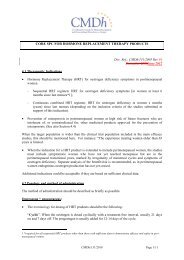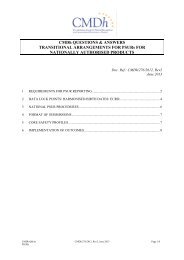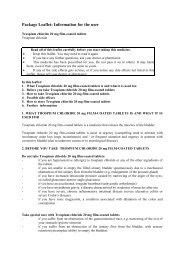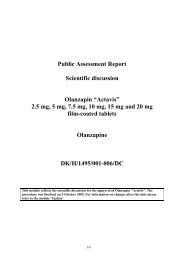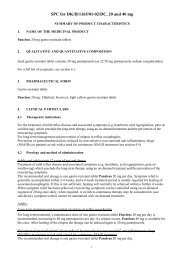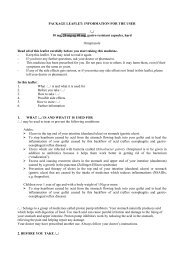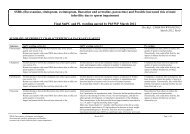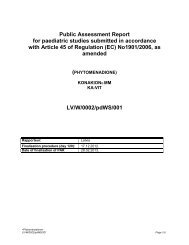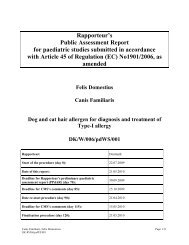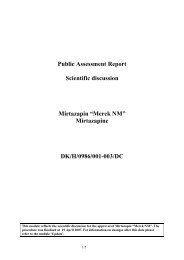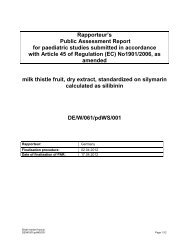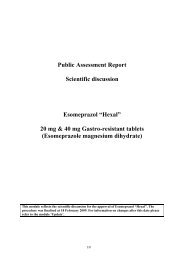Decentralised Procedure Public Assessment Report Oxycodon-HCl ...
Decentralised Procedure Public Assessment Report Oxycodon-HCl ...
Decentralised Procedure Public Assessment Report Oxycodon-HCl ...
You also want an ePaper? Increase the reach of your titles
YUMPU automatically turns print PDFs into web optimized ePapers that Google loves.
<strong>Decentralised</strong> <strong>Procedure</strong><br />
<strong>Public</strong> <strong>Assessment</strong> <strong>Report</strong><br />
<strong>Oxycodon</strong>-<strong>HCl</strong> Sandoz 5/10/20 mg Retardtabletten<br />
Kancodal HEXAL 5/10/20 Retardtabletten<br />
<strong>Oxycodon</strong>hydrochlorid- 1 A Pharma 5/10/20 mg<br />
Retardtabletten<br />
<strong>Oxycodon</strong>e hydrochloride<br />
DE/H/1154-1156/001-003/DC<br />
Applicant: Sandoz Pharmaceuticals GmbH<br />
Hexal AG<br />
1 A Pharma GmbH<br />
Reference Member State DE<br />
The BfArM is a Federal Institute within the portfolio of the Federal Ministry of Health. 1/7
TABLE OF CONTENTS<br />
I. Introduction ................................................................................................................................... 4<br />
II. EXECUTIVE SUMMARY....................................................................................................... 4<br />
II.1 Problem statement..................................................................................................................... 4<br />
II.2 About the product ..................................................................................................................... 4<br />
II.3 General comments on the submitted dossier .......................................................................... 4<br />
II.4 General comments on compliance with GMP, GLP, GCP and agreed ethical principles. .5<br />
III. SCIENTIFIC OVERVIEW AND DISCUSSION ................................................................... 5<br />
III.1 Quality aspects....................................................................................................................... 5<br />
III.2 Nonclinical aspects ................................................................................................................ 6<br />
III.3 Clinical aspects ...................................................................................................................... 6<br />
IV. BENEFIT RISK ASSESSMENT ............................................................................................. 8<br />
2/7 <strong>Public</strong> <strong>Assessment</strong> <strong>Report</strong>
Proposed name of the medicinal<br />
product in the RMS<br />
INN (or common name) of the active<br />
substance(s):<br />
Pharmaco-therapeutic group<br />
(ATC Code):<br />
Pharmaceutical form(s) and<br />
strength(s):<br />
Reference Number for the<br />
<strong>Decentralised</strong> <strong>Procedure</strong><br />
Reference Member State:<br />
Member States concerned:<br />
Applicant (name and address)<br />
Names and addresses of<br />
manufacturers of dosage form<br />
Names and addresses of<br />
manufacturers responsible for batch<br />
release in the EEA<br />
ADMINISTRATIVE INFORMATION<br />
<strong>Oxycodon</strong> Sandoz 5/10/20 mg Retardtabletten<br />
<strong>Oxycodon</strong>-HEXAL 5/10/20 mg Retardtabletten<br />
<strong>Oxycodon</strong>-1A Pharma 5/10/20 mg Retardtabletten<br />
<strong>Oxycodon</strong>e hydrochloride<br />
N02AA05<br />
Prolonged release tablets, 5/10/20 mg<br />
DE/H/1154-1156/01-03/DC<br />
Germany<br />
AT, BE, DK, ES, FI, IE, NL, NO, SE, SI, SK, UK<br />
(CMS varying according to dose strengths and/or procedure<br />
number)<br />
Sandoz Pharmaceuticals GmbH, Raiffeisenstr. 11,<br />
D-83607 Holzkirchen, Germany<br />
Hexal AG, Industriestraße 25, 83607 Holzkirchen,<br />
Germany<br />
1A Pharma GmbH, Keltenring 1 +3, 82041 Oberhaching,<br />
Germany<br />
Salutas Pharma GmbH<br />
Otto-von-Guericke-Allee 1<br />
D-39179 Barleben, Germany<br />
Salutas Pharma GmbH<br />
Otto-von-Guericke-Allee 1<br />
D-39179 Barleben, Germany<br />
with manufacturing site<br />
Otto-von-Guericke-Allee 1, D-39179 Barleben<br />
Salutas Pharma GmbH<br />
Otto-von-Guericke-Allee 1<br />
D-39179 Barleben, German<br />
with manufacturing site<br />
Dieselstrasse 5, 70839 Gerlingen<br />
Lek Pharmaceuticals d.d<br />
Verovskova 57, 1526 Ljubljana<br />
Slovenia<br />
3/7 <strong>Public</strong> <strong>Assessment</strong> <strong>Report</strong>
I. INTRODUCTION<br />
Based on the review of the data and the Applicant’s response to the questions raised by RMS and<br />
CMS on quality, safety and efficacy, the RMS and CMS approved the application for <strong>Oxycodon</strong>e<br />
hydrochloride 5 mg/-10 mg/-20 mg prolonged-release tablets in the treatment of severe pain, which<br />
can be adequately managed only with opioid analgesics.<br />
II. EXECUTIVE SUMMARY<br />
II.1 Problem statement<br />
This application is submitted in accordance with Article 10(1) of Directive 2001/83/EC. The originator<br />
product, OxyContin depottabletit, was first approved in EU member state Finland. The products under<br />
discussion are generic to the originator products already marketed in several European countries.<br />
Germany, the Reference Member State within this <strong>Decentralised</strong> <strong>Procedure</strong>, also acted as Reference<br />
Member State within the Mutual Recognition <strong>Procedure</strong> DE/H/0366/01-05 dealing with the originator<br />
prolonged release tablets containing 5, 10, 20, 40 and 80 mg of oxycodone (Oxygesic®).<br />
II.2 About the product<br />
Classified as belonging to step 3 according to the WHO analgesic ladder, oxycodone is a widely used<br />
and well established opioid analgesic. It has been shown to be as effective as morphine in the<br />
management of severe to most severe pain, i.e. for the treatment of cancer pain, post-operative pain<br />
and non-malignant pain.<br />
<strong>Oxycodon</strong>e acts as an agonist at my, kappa and delta receptors with no antagonist properties. The<br />
pharmacological actions of oxycodone are common to all opioid analgesics, which produce their major<br />
effects on the central nervous system (brain and spinal cord) and smooth muscles.<br />
The indication of the above mentioned medicinal products applied for under the scope of this<br />
<strong>Decentralised</strong> <strong>Procedure</strong> is the treatment of severe pain, which can be adequately managed only with<br />
opioid analgesics<br />
II.3 General comments on the submitted dossier<br />
The originator´s <strong>Oxycodon</strong>e hydrochloride prolonged release formulations, marketed by<br />
Mundipharma throughout the European Union, under the trade names OxyContin® or Oxygesic® are<br />
single unit formulations. These formulations are orally administered twice daily, i.e. in 12 hours<br />
intervals.<br />
The applicant has developed single unit formulations containing 5-20 mg of the drug substance with<br />
similar prolonged release characteristics.<br />
The clinical dossier contains a single- and multiple dose study in fasted state and a single-dose study<br />
in fed state for the 10 and 20 mg oxycodone dose strengths.<br />
For the 5 mg strength only a single-dose study under fasted conditions has been performed. The<br />
applicant justifies the omission of bioequivalence studies for additional dose strengths under the<br />
conditions as laid down in the ‘Note for Guidance on the Investigation of Bioavailability and<br />
Bioequivalence’ (CPMP/EWP/QWP/1401/98) for immediate-release formulations, which also apply<br />
for modified-release formulations.<br />
4/7 <strong>Public</strong> <strong>Assessment</strong> <strong>Report</strong>
II.4 General comments on compliance with GMP, GLP, GCP and agreed ethical<br />
principles.<br />
The RMS has been assured that acceptable standards of GMP are in place for these product types at all<br />
sites responsible for the manufacture and assembly of this product. For manufacturing sites within the<br />
Community, the RMS has accepted copies of current manufacturer authorisations issued by inspection<br />
services of the competent authorities as certification that acceptable standards of GMP are in place at<br />
those sites.<br />
III. SCIENTIFIC OVERVIEW AND DISCUSSION<br />
III.1 Quality aspects<br />
DRUG SUBSTANCE<br />
The active substance oxycodone hydrochloride is described in the European Pharmacopoeia (Ph.<br />
Eur.). The quality of the drug substance oxycodone hydrochloride is controlled in compliance with the<br />
corresponding monograph of the European Pharmacopoeia (Ph Eur).<br />
DRUG PRODUCT<br />
The objective was the development of a product, stable and essentially similar to the innovator<br />
product.<br />
The prolonged-release of the drug substance is caused by the following excipients:glycerol(mono,<br />
tri)docosanoat, medium-chain triglycerides and hydrogenated castor oil..<br />
Oxycocodone hydrochloride is intended for treatment of severe pain.<br />
The questions raised during the evaluation belong to the pharmaceutical development, manufacturing<br />
process as well as to the stability of the drug product.<br />
The ingredients and the manufacturing process of the drug product are considered suitable to produce<br />
a pharmaceutical product of the proposed quality.<br />
All relevant quality characteristics of the drug substance and the drug product (release and shelf-life)<br />
are specified. The proposed limits are accepted.<br />
The description of the analytical methods used to analyse the drug substance and drug product are<br />
adequate, the validation results are plausible.<br />
III.2 Nonclinical aspects<br />
<strong>Oxycodon</strong>e hydrochloride is a substance with well-known pharmacodynamic, pharmacokinetic and<br />
toxicological properties. No new information has been provided which would from a non-clinical<br />
point of view change the positive risk/benefit assessment of the active substance.<br />
Pharmacodynamics<br />
<strong>Oxycodon</strong>e is an opioid agonist with primarily affinity to μ opiate receptors. It is indicated for the<br />
treatment of severe pain.<br />
Pharmacokinetics<br />
<strong>Oxycodon</strong>e is well absorbed from the gastrointestinal tract. Metabolism takes place mainly in the liver<br />
via CYP3A4 and CYP2D6 isoforms. Main metabolites are noroxycodone, oxymorphone and several<br />
glucuronide conjugates. Excretion is via urine and faeces.<br />
<strong>Oxycodon</strong>e crosses the placenta and is excreted into breast milk. The milk: plasma ratio was<br />
calculated to be 3.4:1.<br />
Toxicology<br />
The most severe acute toxic effect of oxycodone is respiratory depression. If <strong>Oxycodon</strong>e is used<br />
repeatedly tolerance as well as physical and psychological dependence may develop.<br />
There is insufficient data on reproduction. No data on fertility and postnatal effects following<br />
5/7 <strong>Public</strong> <strong>Assessment</strong> <strong>Report</strong>
intrauterine exposure is publicly available. <strong>Oxycodon</strong>e did not cause malformations in rats and rabbits<br />
at dosages of 8 mg/kg body weight/day and up to 5 mg/kg body weight/day respectively<br />
(corresponding to 1.5 to 2.5 times of the human dose of 160 mg/day, based on mg/kg basis).<br />
Experience with the use of oxycodone during human pregnancy is insufficient and does not allow a<br />
final assessment.<br />
Most opioid analgesics enter the foetal brain. Thus the administration of oxycodone during pregnancy<br />
may cause respiratory depression and/or withdrawal symptoms in the new-born.<br />
<strong>Oxycodon</strong>e shows clastogenic potential in vitro assays. However, similar effects were not observed<br />
under in vivo conditions even at toxic doses. Altogether, it can be concluded that oxycodone has no<br />
clinical relevant genotoxic potential.<br />
Long-term carcinogenicity studies have not been performed.<br />
SPC<br />
The proposed SPC adequately reflects the actual scientific knowledge on oxycodone hydrochloride for<br />
the relevant indications and is considered acceptable. There are no objections to approval of<br />
<strong>Oxycodon</strong>e 5, 10 and 20 mg prolonged release tablets from a non-clinical point of view.<br />
III.3 Clinical aspects<br />
Pharmacokinetics<br />
The pharmacokinetic characteristics of the originator products are: the dose range is linear for the 10 –<br />
80 mg strengths, the formulations are bioequivalent.. Bioequivalence with the originator product has<br />
been investigated conducting a total of six in-vivo studies:<br />
� A single-dose bioequivalence trial of the 5 mg test and reference product in fasted healthy<br />
volunteers (Study Code: 2006-49-RTA-1)<br />
� A single-dose bioequivalence trial of three 10 mg oxycodone PR tablet formulations (two<br />
different test biobatches plus reference) under fasted and fed conditions in healthy volunteers<br />
(Study Code: 2005-27-RTA-1)<br />
� A single-dose bioequivalence trial of the 10 mg test and reference product in healthy<br />
volunteers under fed conditions (Study Code: 2006-14-RTA-3)<br />
� A single and multiple-dose trial of the 10 mg test and reference product in fasted healthy<br />
volunteers (Study Code: 2005-62-RTA-2)<br />
� A single and multiple-dose bioequivalence trial of three 20 mg oxycodone PR tablet<br />
formulations (test, Oxygesic® and OxyContin® as references) in healthy volunteers under<br />
fasting conditions (Study Code: 2006-50-RTA-1)<br />
� A single-dose bioequivalence trial of three 20 mg oxycodone PR tablet formulations (test,<br />
Oxygesic® , OxyContin®) in healthy volunteers under fed conditions (Study Code: 2006-69-<br />
RTA-3)<br />
As European reference products in these bioequivalence studies Oxygesic 5 mg, 10 mg, 20 mg,<br />
prolonged release tablets, Mundipharma,, were used and in case of the 20 mg studies an additional<br />
arm with OxyContin 20 mg prolonged-release tablets, Mundipharma Pty Limited Australia was added.<br />
.<br />
The study design, analytical methodology and statistical evaluation of the bioequivalence studies for<br />
the prolonged release tablets were appropriately designed and conducted in compliance with the<br />
recommendations of the relevant guidelines for GCP and GLP.<br />
Plasma concentrations of oxycodone were determined by validated and specific analytical methods<br />
using HPLC with MS/MS detection. The lower limit of quantification (LLOQ) was determined as 0.5<br />
ng/ml. Linearity could be shown over the concentration range from 0.5 ng/ml to 100.0 ng/ml for<br />
oxycodone.<br />
6/7 <strong>Public</strong> <strong>Assessment</strong> <strong>Report</strong>
For the 10 mg and 20 mg strengths the entire bioequivalence data set (single dose fasted, single dose<br />
fed and multiple dose) has been provided. Results of comparative in-vitro dissolution have been<br />
provided that demonstrate similarity of the in-vitro dissolution profiles of the 5 mg and 10 mg<br />
strengths, thus justifying extrapolation of in-vivo bioequivalence data in the case of the 5 mg<br />
strength. The results of the six bioequivalence studies demonstrate interchangeability of the test and<br />
reference formulation for all three dose strengths in clinical practice.<br />
Pharmacodynamics<br />
Not applicable<br />
Clinical efficacy<br />
Not applicable<br />
Clinical safety<br />
The adverse events observed during the bioequivalence studies were typical for the administration of<br />
strong analgesics to opioid naïve healthy volunteers. Mainly, they comprised nausea, vomiting, and<br />
dizziness and occurred with about the same frequency in the test and the reference group. The adverse<br />
event profile of oxycodone in the six bioequivalence studies is adequately addressed under section 4.8<br />
of the submitted SPC.<br />
Pharmacovigilance system<br />
All aspects of the Guideline on Monitoring of Compliance with Pharmacovigilance Regulatory<br />
Obligations and Pharmacovigilance Inspections (version March 06 public consultation) and of Volume<br />
9A are adequately addressed.<br />
Germany is aware that Volume 9A does not ask for examinations evaluating the success of training<br />
systems, it is however a requirement of the German AMWHV (a regulation on GMP) and the global<br />
drug safety department of Sandoz is located in Germany. We appreciate that the implementation of an<br />
e-learning tool comprising a proficiency test is planned for 2008.<br />
IV. BENEFIT RISK ASSESSMENT<br />
The benefit/risk ratio is positive and therefore the RMS has considered that the application for<br />
<strong>Oxycodon</strong>e hydrochloride 5 mg/-10 mg/-20 mg prolonged-release tablets in the treatment of severe<br />
pain, which can be adequately managed only with opioid analgesics is approvable.<br />
7/7 <strong>Public</strong> <strong>Assessment</strong> <strong>Report</strong>



